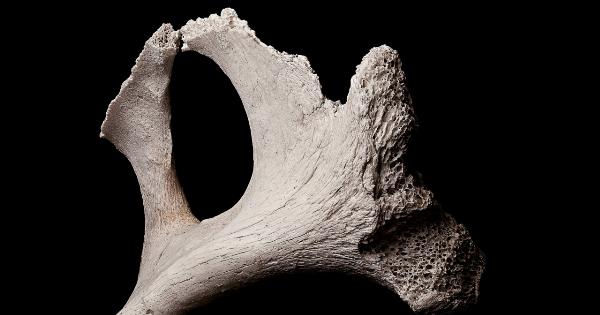Bones are an integral part of the human body, providing structure, support, and protection to various organs.
However, fractures, which occur when a bone breaks due to excessive force or weakness, can have serious implications for individuals of all ages. From children involved in sports activities to elderly individuals suffering from osteoporosis, bone fractures are a crisis that needs urgent attention.
In this article, we will explore the causes, types, treatments, and preventive measures for bone fractures.
Causes of Bone Fractures
While bones are incredibly strong and durable, they can still succumb to fractures under certain circumstances. The causes of bone fractures can vary, ranging from accidents and trauma to underlying medical conditions:.
1. Accidents and Trauma
High-impact accidents, such as falls, car crashes, or sports injuries, are common causes of bone fractures. When a significant force is applied to a bone, it can break or crack.
Fractures can also occur as a result of direct blows, such as getting hit by an object or a sudden twist or bend during physical activities.
2. Osteoporosis
Osteoporosis is a condition characterized by the loss of bone density, making bones brittle and prone to fractures. Women, particularly after menopause, are at a higher risk of developing osteoporosis.
The weakened bone structure can lead to fractures even with minimal impact or stress on the bone.
Types of Bone Fractures
Bone fractures can be classified into various types based on the nature and location of the break:.
1. Closed Fracture
A closed fracture, also known as a simple fracture, refers to a break in the bone without any open wounds or external exposure of the broken bone. In this type of fracture, the bone doesn’t protrude through the skin.
2. Open Fracture
An open fracture, also known as a compound fracture, involves a broken bone that pierces through the skin, leaving the fracture site exposed to the external environment.
Open fractures are at a higher risk of infection and can be more severe due to the potential damage to surrounding tissues and blood vessels.
3. Greenstick Fracture
Greenstick fractures commonly occur in children whose bones are still growing and more flexible. In this type of fracture, the bone bends and cracks but doesn’t break completely, resembling a greenstick snapping partially.
4. Comminuted Fracture
Comminuted fractures refer to breaks in which the bone shatters into multiple fragments. These fractures often occur due to high-energy trauma, such as a car accident or a fall from a significant height.
5. Stress Fracture
Stress fractures are small cracks in the bone that occur due to repetitive stress or overuse. Athletes, particularly those involved in running or jumping sports, are vulnerable to stress fractures.
6. Compression Fracture
A compression fracture most commonly affects the vertebrae in the spine, especially among older individuals with osteoporosis. As the name suggests, the bone collapses or compresses under pressure.
Treatments for Bone Fractures
The treatment approach for bone fractures depends on the type, severity, and location of the fracture. The primary objective of treatment is to realign the broken bone fragments, promote healing, and restore functionality:.
1. Immobilization
Immobilization involves the use of casts, splints, or braces to prevent any movement in the fractured bone. This allows the bone to heal properly without further displacement or damage. Immobilization is commonly used for closed fractures.
2. Surgery
In more severe cases, surgical intervention may be necessary to realign the bones and ensure proper healing. Internal fixation, such as the use of screws, plates, or rods, helps stabilize the fracture and facilitates faster recovery.
3. Medication
Medications can play a crucial role in bone fracture treatment. Pain relievers are often prescribed to manage the discomfort associated with the fracture.
Additionally, medications like bisphosphonates may be recommended for individuals with osteoporosis to help improve bone density and prevent future fractures.
Preventive Measures for Bone Fractures
While some fractures may be difficult to prevent, there are several proactive steps individuals can take to minimize their risk:.
1. Regular Exercise and Weight-Bearing Activities
Engaging in regular exercise and weight-bearing activities, such as walking, running, or strength training, can help improve bone density and strength, reducing the risk of fractures.
It is essential to consult with a healthcare professional before starting any exercise regimen, especially for individuals with pre-existing medical conditions.
2. Balanced Diet
A well-balanced diet rich in calcium, vitamin D, and other essential nutrients is essential for maintaining strong and healthy bones.
Calcium-rich foods include dairy products, leafy green vegetables, and fortified cereals, while vitamin D can be obtained from sunlight exposure, fatty fish, and fortified foods.
3. Fall Prevention
For older individuals at a higher risk of fractures due to osteoporosis and balance issues, fall prevention is crucial.
Removing tripping hazards, such as loose rugs or clutter, installing handrails, and using assistive devices can significantly reduce the risk of falls and subsequent fractures.
Conclusion
Bone fractures are a crisis that demands urgent attention. Whether caused by accidents, trauma, or underlying medical conditions, fractures can have a significant impact on an individual’s quality of life.
Understanding the causes, types, treatments, and preventive measures for bone fractures is vital to ensure timely intervention and promote bone health. By taking preventive measures and seeking appropriate treatment, individuals can strengthen their bones and reduce the risk of fractures, contributing to a healthier and more active life.




























